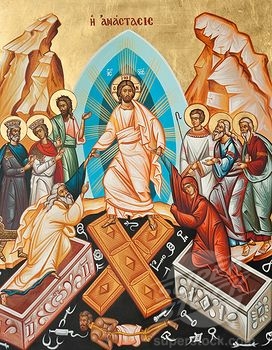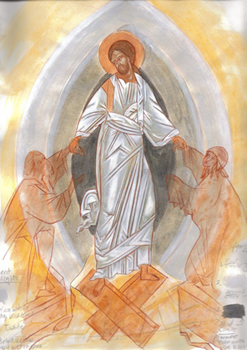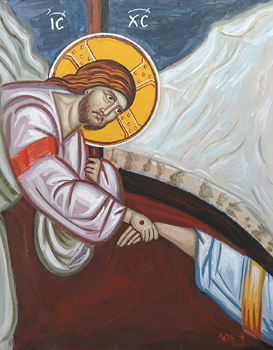For Sunday April 12, 2020
Lectionary Readings (Revised Common Lectionary, Year A)
Jeremiah 31:1-6
Psalm 118:1-2, 14-24
Acts 10:34-43
John 20:1-18
Easter will feel different this year. If we were living in “ordinary” times, our celebrations this week would be communal, festive, and well-orchestrated. We’d wear our best clothes, sit in packed pews, and listen to trumpet fanfares. Some of us would gather before dawn to listen to the great stories of our faith. Some of us would process with the Alleluia banners we buried at the beginning of Lent. Some of us would share brunch together in our parish halls. Some of us would delight in watching our children hunt for Easter eggs on our church grounds.
Whatever our traditions, we would enact them together, gathering as church families to celebrate the best and boldest news ever told: "The tomb is empty! Death is undone! Christ is risen! He is risen, indeed!”
The news has not changed. But the world around us has. Or at least, the pain that always wracks our world has been freshly uncovered. This year, most of us will not gather in person on Easter. We will celebrate online, as best we can, or create Holy Week rituals within our own homes. But the fear, sorrow, numbness, and shock we feel in the face of the Covid-19 pandemic will stay with us, infusing our worship experiences, and maybe even mocking them. What does it mean, after all, to celebrate resurrection when people near and far are dying by the thousands? What good can it do to insist that the tomb is empty when body bags are in short supply, mortuaries are at capacity, and mourners can’t gather to bury their dead?
I don’t know. I’ll begin by saying that, because it’s the most honest thing I can say. I don’t know. I’m scared, I’m grieving, I’m bewildered, I’m struggling. Yes, I believe with all my heart that Christ is risen, and that his rising was and is radically consequential. But I’m still fumbling. There is so much I long to know, but don’t.
What feels possible now is to stay very close to the story. Not to everything pretty we’ve added to it over the millennia, but to the messy, chaotic, barely comprehensible Easter story itself. Scattered graveclothes. Confused running. Timid peeks into empty tombs. Tears and more tears. Hope and uncertainty, intertwined. Faith waiting in the shadows for understanding.
 |
I’ve spent the past few days reading John’s account of the resurrection story over and over again, hoping to internalize it. A few lines have stood out to me as especially relevant for these perilous days, so here they are:
“While it was still dark.” In John’s version of the story, Mary Magdalene discovers the empty tomb before sunrise, while it is still dark. Frederick Beuchner expands on this detail to comment on “the darkness of the resurrection itself.” He describes the first Easter morning as a time “when it was hard to be sure what you were seeing.”
The Gospel tells us that the disciples stumbled around in the half-light on the third day after Jesus’s crucifixion, running here and there in their confusion. Were those really angels, sitting in the unlit tomb? Were those misshapen shadows Jesus’s graveclothes? The stranger lingering outside with the oddly familiar voice — was he a gardener? Or… someone else?
Early in the morning, while it was still dark. That’s where Easter begins.
Needless to say, this is frustrating. Why can’t the promise of Easter come to us in blazing brightness? With unmistakable clarity? Why all this stumbling around in the darkness? Why so much occasion for bewilderment?
Could it be that Death is such an abyss, such a horror, such a violation, that only a mystery as profound as resurrection-in-the-dark will suffice?
Over these past few weeks, we have seen Death magnified, Death exceeding all boundaries we try to impose on it. Can we rest in our shiny religious certainties any longer, given the scope of these losses? Maybe we need mystery right now — mystery commensurate to a planet reeling in loss. Angels in murky places. A stranger’s voice, revealing the divine. Transformations both inexplicable and uncontainable. Maybe we need God, who dwells in light so bright and so unapproachable, he covers us in merciful darkness to protect our fragile sight.
In my own life, clarity, hope, and healing come when I’m willing to linger in hard, barren places, places where the usual platitudes fall flat, and all easy answers prove inadequate. Jesus comes in the darkness, and sometimes it takes a long time to recognize him. He doesn’t look the way I expect him to look. He doesn’t let me cling to my old ideas of him. He disappears again just as I grab hold of him. But he comes, nevertheless, and he calls my name even when I’m lost in grief. And in that instant, I recognize both myself and him.
There is so much about the resurrection that we don’t know. What we do kno — what we need to know — is that somehow, in an ancient tomb on a starry night, God worked in secret to bring life out of death. Somehow, in the utter darkness, God saved the world.
“He saw and believed; for as yet they did not understand…” This is an odd, almost throwaway line in the text, but I find great comfort in it. John’s Gospel tells us that the “beloved disciple” entered the tomb after Peter, saw Jesus’s linen wrappings lying in the place where a body should have been, and believed without understanding. Even though he’d been raised on the Scriptures, he didn’t yet comprehend their significance for his circumstances. Still, he believed.
It’s not clear from the text what he believed, or how deeply. Did he believe that Jesus’s body had been stolen? Did he embrace the possibility that Jesus was alive? Did he trust that God had vanquished death and vindicated his Messiah?
We don’t know. We only know that he “saw and believed.” Meaning, he leaned into the truth of his experience, the evidence of his own eyes. He gave himself over, without cynicism or despair, to whatever messy faith was possible in the moment, and then he left the door open for his faith to deepen. He believed as he could, trusted as he could. No more, no less.
I love very much that this text honors the gap between faith and understanding, because it’s a gap I know too well. I believe but I don’t (yet) understand. I believe in the resurrection, but I don’t understand Death’s ongoing cruelty. I believe that Jesus reigns, but I don’t understand the elusive nature of his kingdom. I believe that all things will be well, but I don’t understand why they’re not all well now.
Saint Anselm of Canterbury’s motto for the Christian life was “faith seeking understanding.” I like that. It invites me to begin right where I am. What have I experienced of Jesus so far? Can I hang onto the faith that is possible in light of my experience, incomplete though it is?
 |
Often, it’s only in retrospect, only as I look back at the “gravesides” of my life, that I see how faith has led to understanding. Poet R.S. Thomas describes the process this way in his poem, “The Answer:" "There have been times/when, after long on my knees/ in a cold chancel, a stone has rolled/from my mind, and I have looked/in and seen the old questions lie/ folded and in a place/by themselves, like the piled/graveclothes of love’s risen body.”
“Why are you weeping?” In our Gospel story, both the angels and “the gardener” ask Mary why she's so desperately sad. I’m drawn to this poignant, heartrending question for two reasons. First, the question honors sorrow as a legitimate and faithful pathway to revelation. Mary Magdalene sees Jesus because she stays put in the place where her pain is. She stands and weeps, giving the grief, desolation, hopelessness, and agony of her circumstances their due. Peter and the beloved disciple leave when they see the empty tomb, but Mary stays, bewildered and bereft. She refuses to abandon what is real, even when what is real is unbearable.
Second, the question suggests that God cares about our sorrow. The question is offered to Mary two times, giving her ample opportunity to express her pain. Why are you weeping? What is it that you have lost? What are you seeking? What has caused you to linger at the grave? What is breaking your heart?
I’d be hard-pressed to find a better question for the time and place we find ourselves in this Easter. Why are you weeping? Are you weeping for someone who has died of the coronavirus? Are you weeping in fear that you or someone you love might contract it? Are you sad because you’ve lost your job? Are you grieving for the unemployed and uninsured? Are you in tears because the world has changed, and your place in it feels newly uncertain or shaky? Are you grieving because your faith isn’t sustaining you as wholly as you thought it would? Are you sad because you miss the weekly comforts of church, Eucharist, ritual, community? Are you crying because you’re lonely? Are you weeping for your children or grandchildren, who must inherit a world so filled with pain?
Why are you weeping?
To ask this question — and to answer it honestly — is not faithless. It is truthful and it is loving, and it is a place to begin. Loving truthfulness is God’s signature.
“Do not hold onto me.” I’ll be honest: this line makes me wince, and part of me wishes Jesus hadn’t said it. Didn’t it make all the sense in the world for Mary to hold on tight to Jesus? Who among us wouldn’t cling, if a loved one unexpectedly returned? Wasn’t Mary simply expressing her love?
I wonder if what Jesus cautioned her against in his seeming rebuke was not love, but possessiveness, insecurity, and fear. An unwillingness to let things change. An unwillingness to mature in her comprehension and her calling. I wonder if Jesus was saying, “Mary, you are more than a disciple now. You are a witness. A preacher. An apostle to the apostles. Do not hold onto what you thought you knew about yourself and about me. Do not cling to the way things used to be. Loosen your grip on the past. Stop expecting life to be what it was before the cross and the grave. I am doing something new in the world. I am doing something new in you. Don’t cling. Don’t hold on. Grow.
When the worst of our current pandemic is over, we the Church will be strongly tempted to “hold on” in nostalgia and lethargy. To pretend that nothing has changed. To cling to our old, most-familiar practices, and avoid asking hard, creative questions about our place and our relevance in a post-Covid world. Can we hear Jesus’s painful but necessary words as words of wisdom, spoken in love? Do not hold onto me. Allow new life — risky and uncertain though it is — to spring forth.
"I have seen the Lord." The Easter story begins with tears and ends with proclamation. Having encountered Jesus, Mary runs to tell her friends the news. She doesn’t hesitate to bear witness to what she has seen and heard — even though the context into which she brings her good news is rife with anxiety, exhaustion, trauma, and disbelief.
We know from the other Gospel accounts that the disciples don’t believe Mary right away. But she knows what she has seen, and she doesn't allow the zeitgeist of doubt, cynicism, and incomprehension to blunt her proclamation. She insists on resurrection because resurrection is so good, so essential, so life-saving, so true. She knows that the world needs to hear it, so she says it boldly, bravely, joyfully. Without apology.
The world still needs to hear it. Especially now, as Death breathes down our necks, the future feels precarious, and all of our worst fears run wild. The grave is empty, this sorrow is not forever, and the same Jesus who conquered death is still here, with us and among us.
 |
So. Where have you seen the Lord? What is your proclamation? Who will you tell?
This week, as I was preparing to write this essay, I came across a 2004 Easter sermon from Rowan Williams, the former Archbishop of Canterbury. In his beautiful words about the ongoing significance of resurrection, I saw the Lord. I saw the radical nature of the Easter faith we profess during this season of illness and death. So I’ll close by sharing his words:
“The goodness of the resurrection news is most evident for those who have lost people they love to any sort of incomprehensible evil - the tragedies of dementia, the apparent meaninglessness of accident, the horrors of violence or injustice. Think back for a moment to the days when death squads operated in countries like Argentina or El Salvador: the Christians there developed a very dramatic way of celebrating their faith, their hope and their resistance. At the liturgy, someone would read out the names of those killed or 'disappeared', and for each name someone would call out from the congregation, Presente, 'Here'.
“When the assembly is gathered before God, the lost are indeed presente; when we pray during the eucharist 'with angels and archangels and the whole company of heaven', we say presente for all those the world (including us) would forget and God remembers. With angels and archangels; with the butchered Rwandans of ten years ago and the butchered or brutalised Ugandan children of last week or yesterday; with the young woman dead on a mattress in King's Cross after an overdose and the childless widower with Alzheimer's; with the thief crucified alongside Jesus and all the thousands of other anonymous thieves crucified in Judaea by an efficient imperial administration; with the whole company of heaven, those whom God receives in his mercy. And with Christ our Lord, the firstborn from the dead, by whose death our sinful forgetfulness and lukewarm love can be forgiven and kindled to life, who leaves no human soul in anonymity and oblivion, but gives to all the dignity of a name and a presence. He is risen; he is not here; he is present everywhere and to all. He is risen: presente.”
Yes, Easter will feel different this year. But even now, angels accompany us in the darkness, faith remains possible, understanding will come, the voice of the risen Jesus calls us by name, and the God who destroyed death is ever able to turn our tears into joy. All is not lost. Remember: we have seen the Lord.
Debie Thomas: debie.thomas1@gmail.com
Image credits: (1) Turtle Rock; (2) Anastasis Studio of Iconography; and (3) Amazon.com.





